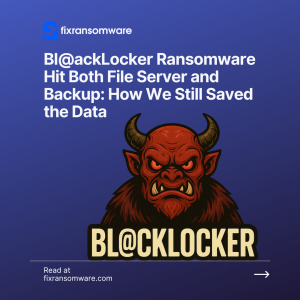When staff arrived on Monday morning, the network looked fine at first. Users could log in, email worked, and line-of-business apps still opened. The real shock came when they tried to access shared folders. Project files failed to open, finance spreadsheets were corrupted, and archive folders showed a strange new extension like .blacklocker on almost every file. A ransom note confirmed it: Bl@ackLocker Ransomware had encrypted both the main file server and the backup server.
This is the nightmare scenario for many companies. Yet in this case, the team still managed to recover critical data without paying the attackers. Here is how they did it.
When Bl@ackLocker Ransomware Takes File Server and Backup
The first discovery was brutal: not only was the file server encrypted, but the backup server that synced every night was also locked. Because Bl@ackLocker Ransomware had access to the same network, it encrypted recent backups right after finishing with live data.
However, the team resisted the urge to reboot everything or reinstall servers. Instead, they:
- Took the file server and backup server offline.
- Blocked remote access, VPN, and any suspicious admin accounts.
- Stopped users from copying encrypted files to laptops or cloud storage.
By acting quickly, they froze the incident. No more files were touched, and the environment was stable enough for proper analysis.
Explaining the Situation to Management
Management needed to understand the damage in simple terms. The IT lead prepared a short summary:
- What was hit: main file server and the primary backup server.
- What was still working: email, ERP, and several cloud services.
- Main risk: recent backups were encrypted; older offline copies might still exist.
Because of this clear status, leadership could prioritise. They agreed that recovering active finance, legal, and operations folders was more important than restoring every old archive. That decision shaped the rest of the recovery plan.
Technical Assessment of the Bl@ackLocker Ransomware Incident
Next, the team started a structured technical review instead of random trial and error.
They documented:
- Server roles, storage layout, and backup schedule.
- Which shares were encrypted and which, if any, remained untouched.
- The time window when Bl@ackLocker Ransomware likely ran.
They then collected a sample of encrypted files and logs. At this point, they contacted specialists via FixRansomware.com and submitted samples through app.FixRansomware.com. The goal was to confirm the strain, understand typical behaviour of Bl@ackLocker Ransomware, and avoid destructive “DIY fixes”.
For additional guidance, they also consulted the official CISA Ransomware Guide, which strongly recommends isolating systems, preserving evidence, and planning recovery before touching production data.
Building a Recovery Plan With No Fresh Backups
Because the most recent backups were encrypted, the team needed a blended strategy:
- Clone first, recover later
Storage from both the file server and the backup server was cloned. All tests happened on the clones. This way, if a tool corrupted data, the original evidence still existed. - Locate older offline backups
Fortunately, the company kept monthly offline copies on removable media stored offsite. These backups were older, but clean. They became the backbone for restoring core folder structures. - Merge restored data with targeted decryption
Older clean data was restored from offline backups. For more recent documents that existed only in encrypted form, specialists attempted targeted decryption based on the behaviour of Bl@ackLocker Ransomware. This hybrid approach allowed the company to rebuild a nearly current view of its files. - Prioritise business-critical folders
Finance, contracts, and active project directories came first. Less critical archives waited until the most important teams could work again.
Throughout the process, every major step was logged: what was tested, where it was tested, and which result was kept. That log later helped internal audit and reduced disputes about “missing” files.
Lessons Learned and Hardening After Bl@ackLocker Ransomware
After the crisis passed and users could work again, the company treated the incident as a forced audit rather than a one-time disaster.
They:
- Shortened backup intervals and added at least one immutable or offline backup tier.
- Tightened admin rights and enforced multi-factor authentication.
- Reduced exposed services and reviewed remote access policies.
- Created a simple incident response playbook so people know what to do next time.
Bl@ackLocker Ransomware had managed to hit both the file server and backup, but it did not end the business. Because the team followed a structured approach—contain, assess, then recover—they avoided paying ransom and turned a worst-case scenario into a painful but valuable lesson.


